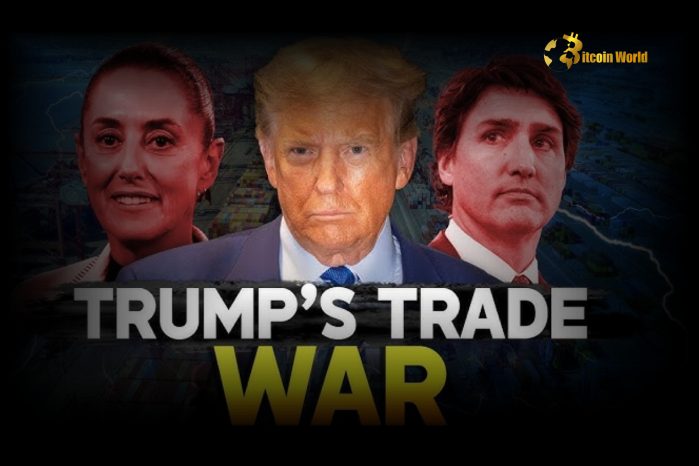
In the fast-paced world of artificial intelligence, where innovation is the name of the game, Anthropic has just dropped a bombshell. Imagine an AI that doesn’t just spit out quick answers, but actually takes its time, ponders, and ‘thinks’ deeply about your questions. That’s precisely what Anthropic’s new AI model , Claude 3.7 Sonnet, promises to deliver. For crypto enthusiasts and tech-savvy individuals who understand the power of sophisticated algorithms, this development is a game-changer. Let’s dive into why Claude 3.7 Sonnet is making waves and what it means for the future of AI interactions. Unveiling Claude 3.7 Sonnet: A New Era of AI Reasoning Model Anthropic is calling Claude 3.7 Sonnet the industry’s first “hybrid AI reasoning model .” But what exactly does that mean? Unlike typical AI models that offer a single approach to answering questions, Claude 3.7 Sonnet is designed to be versatile. It can provide both rapid, real-time responses and more considered, in-depth answers, depending on what you need. This is a significant leap forward, moving away from the often confusing model selection process that users currently face with many AI chatbots. Here’s a breakdown of what makes Claude 3.7 Sonnet stand out: Hybrid Reasoning: This innovative design allows the AI model to switch between quick and deep thinking modes within a single model. No more choosing between different models for different levels of complexity. User-Controlled Reasoning: You get to decide whether to activate the model’s “reasoning” abilities. This control lets you tailor the AI’s approach to the task at hand, whether you need a fast answer or a thoroughly considered one. Simplified User Experience: Anthropic aims to streamline AI interaction. Instead of overwhelming users with numerous model options, Claude 3.7 Sonnet offers a unified solution that adapts to various needs. How Does Anthropic’s Revolutionary Hybrid AI Reasoning Model Work? The core concept behind Claude 3.7 Sonnet is to mimic human-like thinking processes. Traditional AI models often rely on pattern recognition and quick data retrieval. However, reasoning models like Claude 3.7 Sonnet take a different approach. They break down complex problems into smaller, manageable steps. This process, inspired by deductive reasoning, allows the AI to explore different angles, consider various possibilities, and ultimately arrive at a more accurate and nuanced answer. Think of it like this: Feature Traditional AI Models Claude 3.7 Sonnet (Hybrid Reasoning Model) Reasoning Approach Direct, pattern-based response Step-by-step problem decomposition Thinking Time Fast, immediate answers Variable, user-controlled ‘thinking’ duration Model Selection Multiple models for different tasks Single, versatile hybrid model Output Quality Good for simple queries Enhanced accuracy and nuance for complex questions This method is especially beneficial for tasks requiring in-depth analysis, such as complex coding problems or intricate strategic planning. For those in the crypto space dealing with complex market analysis or smart contract development, the potential of a robust reasoning model is immense. Claude 3.7 Sonnet vs. The Competition: Pricing and Performance Benchmarks While Claude 3.7 Sonnet boasts impressive capabilities, it’s essential to consider its cost and performance relative to other AI models in the market. Anthropic has priced Claude 3.7 Sonnet at $3 per million input tokens and $15 per million output tokens. Let’s see how this stacks up against competitors like OpenAI and DeepSeek: Model Input Tokens (per 1M) Output Tokens (per 1M) Type Claude 3.7 Sonnet $3.00 $15.00 Hybrid Reasoning OpenAI o3-mini $1.10 $4.40 Reasoning Model DeepSeek R1 $0.55 $2.19 Reasoning Model Claude 3.7 Sonnet is positioned as a premium offering, reflecting its hybrid nature and advanced capabilities. While models like o3-mini and R1 are cheaper, they are strictly reasoning models and lack the hybrid versatility of Claude 3.7 Sonnet. Anthropic argues that the enhanced performance and flexibility of their AI model justify the higher price point, especially for users who need a comprehensive AI solution. Performance benchmarks further support Anthropic’s claims: SWE-Bench (Real-world coding tasks): Claude 3.7 Sonnet achieved 62.3% accuracy, outperforming OpenAI’s o3-mini (49.3%). TAU-Bench (Simulated retail interaction): Claude 3.7 Sonnet scored 81.2%, surpassing OpenAI’s o1 model (73.5%). These results indicate that Claude 3.7 Sonnet excels in real-world applications, particularly in complex tasks that demand robust reasoning and adaptability. Anthropic’s Vision: AI That Thinks Like You, But Better? Anthropic AI isn’t just aiming for incremental improvements; they’re envisioning a future where AI seamlessly integrates into our daily lives, understanding our needs and adapting to them intuitively. Diane Penn, Anthropic’s product and research lead, highlighted this vision, stating that eventually, Claude should automatically determine the optimal “thinking” time for each question, much like humans do. This approach is reflected in Claude 3.7 Sonnet’s “visible scratch pad” feature. Users can actually see Claude’s thinking process for most prompts, offering unprecedented transparency into how the AI model arrives at its conclusions. While some parts of the process might be redacted for safety reasons, this level of visibility builds trust and provides valuable insights into the AI’s reasoning. Claude Code: An Agentic Coding Tool for Developers Alongside Claude 3.7 Sonnet, Anthropic AI is also launching Claude Code, an agentic coding tool currently in research preview. This tool is designed to empower developers by allowing them to interact with Claude directly from their terminal. Imagine being able to: Analyze Codebases: Use simple English commands to understand project structures. Modify Code: Make changes to codebases using natural language instructions. Automate Tasks: Test for errors and push code to repositories directly through Claude Code. Claude Code promises to streamline the development process, making it more efficient and accessible. For developers in the crypto space working on blockchain projects, smart contracts, or decentralized applications, this tool could significantly enhance productivity and simplify complex coding tasks. The Road Ahead: Anthropic Leading the AI Revolution? Anthropic AI is making a bold move by releasing Claude 3.7 Sonnet and Claude Code. In a market where new AI models are constantly emerging, Anthropic is aiming to lead the pack, shifting from a historically cautious approach to a more assertive stance. However, the competition is fierce. OpenAI is expected to release its own hybrid AI model soon, as hinted by CEO Sam Altman. The race for AI supremacy is heating up, and Anthropic’s latest innovations are a clear signal that they are ready to compete at the highest level. The question remains: Can Anthropic maintain its lead? With Claude 3.7 Sonnet’s groundbreaking hybrid reasoning capabilities and Claude Code’s developer-centric tools, Anthropic AI is certainly positioning itself as a major player in the AI revolution. For those in the cryptocurrency and broader tech world, keeping a close eye on Anthropic’s advancements is crucial, as they are shaping the future of how we interact with artificial intelligence. To learn more about the latest AI market trends, explore our article on key developments shaping AI features.
Bitcoin World
You can visit the page to read the article.
Source: Bitcoin World
Disclaimer: The opinion expressed here is not investment advice – it is provided for informational purposes only. It does not necessarily reflect the opinion of BitMaden. Every investment and all trading involves risk, so you should always perform your own research prior to making decisions. We do not recommend investing money you cannot afford to lose.
Struggles Persist in Cryptocurrency Markets Despite Legal Resolutions

Bitcoin struggles to gain traction despite legal resolutions with the U.S. DOJ. Continue Reading: Struggles Persist in Cryptocurrency Markets Despite Legal Resolutions The post Struggles Persist in Cryptocurrency Markets Despite Legal Resolutions appeared first on COINTURK NEWS . Bitcoin World

Shocking Trump Tariffs: 25% Levy on Canada and Mexico Sparks Trade War Fears
Buckle up, crypto enthusiasts and market watchers! President Trump has just dropped a bombshell that could send ripples through the global economy and, potentially, into the cryptocurrency markets. He’s confirmed a hefty 25% tariff on goods from Canada and Mexico, effective after March 4th. This move, initially framed around border security, is now being touted as a boon for the US economy . But what does this really mean, and how might it impact your crypto portfolio? Let’s dive into the details. What are the Trump Tariffs and Why Now? According to a recent post by Watcher Guru on X, President Trump has doubled down on his protectionist trade policies. He asserts that these tariffs are not just about border security anymore; they are about revitalizing the US economy . He believes these tariffs will make the United States “extremely liquid and rich again.” This echoes his previous trade strategies, but the timing and context are crucial. Here’s a breakdown of the key points: 25% Tariffs Confirmed: President Trump has officially stated that a 25% tariff will be imposed on goods imported from Canada and Mexico. Effective Date: These tariffs are set to take effect after March 4th. Justification: Initially linked to border security concerns, the rationale has shifted to boosting the US economy . Source: The announcement was highlighted by Watcher Guru on X, indicating its public and widely disseminated nature. Analyzing the Potential Economic Impact of Trump Tariffs The immediate question on everyone’s mind is: what will be the economic impact of these tariffs? While President Trump paints a rosy picture of a richer and more liquid US, economists and trade experts are raising concerns. Let’s break down the potential benefits and challenges: Potential Benefits (as claimed): Increased Domestic Production: Tariffs could make imported goods more expensive, theoretically encouraging businesses to produce goods within the US, boosting domestic industries. Revenue Generation: The tariffs themselves will generate revenue for the US government. Stronger Negotiating Position: Tariffs can be used as leverage in trade negotiations with Canada and Mexico. Potential Challenges and Concerns: Higher Consumer Prices: Tariffs are essentially taxes on imports, which are often passed on to consumers in the form of higher prices for goods and services. This can lead to inflation. Retaliatory Tariffs: Canada and Mexico are likely to retaliate with their own tariffs on US goods, sparking a full-blown trade war . This could hurt US exporters and further disrupt supply chains. Damage to Trade Relationships: Imposing tariffs can strain diplomatic and trade relationships with key partners like Canada and Mexico, potentially leading to long-term economic and political repercussions. Supply Chain Disruptions: Businesses rely on complex global supply chains. Tariffs can disrupt these chains, leading to inefficiencies and higher costs. Negative Impact on Specific Sectors: Certain sectors, particularly those heavily reliant on imports from Canada and Mexico or those exporting to these countries, will be disproportionately affected. For example, the automotive industry, agriculture, and manufacturing could face significant headwinds. Could This Spark a Trade War? Examining the Trade War Scenario The imposition of these Trump Tariffs significantly increases the risk of a trade war . When one country imposes tariffs, the affected countries often retaliate with their own tariffs, creating a cycle of escalating trade barriers. This can lead to: Reduced International Trade: As tariffs increase, trade volumes decrease, harming global economic growth. Economic Slowdown: Trade wars can contribute to economic slowdowns or even recessions in the countries involved and globally. Market Volatility: Uncertainty surrounding trade wars can create significant volatility in financial markets, including cryptocurrency markets. Investors tend to become risk-averse during periods of trade tensions. Historically, trade wars have rarely benefited any nation in the long run. They often lead to higher costs for businesses and consumers, reduced economic growth, and strained international relations. Impact on Cryptocurrency and Financial Markets While the direct link between Trump Tariffs and cryptocurrency might not be immediately obvious, the broader economic impact can certainly influence the crypto market. Here’s how: Economic Uncertainty: Trade wars and tariffs create economic uncertainty. In times of uncertainty, investors may seek refuge in assets perceived as safe havens. While cryptocurrency is not universally considered a safe haven, some investors view it as an alternative asset class that can perform independently of traditional markets. Increased uncertainty could drive some investment towards crypto. Inflationary Pressures: Tariffs can contribute to inflation. Cryptocurrencies like Bitcoin are sometimes touted as a hedge against inflation, although this is still a debated topic. If tariffs lead to noticeable inflation, it could increase interest in cryptocurrencies as a potential store of value. Market Sentiment: Negative news surrounding trade wars can dampen overall market sentiment. This can affect all asset classes, including cryptocurrencies. However, crypto’s inherent volatility means it can also react in unpredictable ways to such news. Dollar Strength/Weakness: The impact on the US dollar is complex. Initially, tariffs might be seen as positive for the dollar due to potential domestic production increases. However, if a trade war escalates and damages the US economy, it could weaken the dollar. Dollar weakness can sometimes be correlated with increased crypto prices, as crypto is often priced against the dollar. It’s important to remember that the cryptocurrency market is influenced by a multitude of factors, and trade policy is just one piece of the puzzle. However, significant shifts in global trade dynamics can have cascading effects throughout the financial system. Actionable Insights: Navigating the Tariff Terrain So, what can you do as a crypto investor or market observer in light of these Trump Tariffs ? Stay Informed: Keep a close eye on developments related to trade policy and the reactions from Canada and Mexico. Follow reputable news sources and economic analysts. Diversify Your Portfolio: Diversification is always a good strategy, especially during times of uncertainty. Don’t put all your eggs in one basket, whether it’s crypto or any other asset class. Manage Risk: Be aware of the increased market volatility that trade tensions can bring. Consider adjusting your trading strategies to manage risk effectively. Long-Term Perspective: Try to maintain a long-term perspective. Short-term market fluctuations are common, especially in the crypto world. Focus on the long-term fundamentals and potential of your investments. Consider Stablecoins: In periods of high volatility, you might consider temporarily moving some assets into stablecoins to reduce risk while staying within the crypto ecosystem. Conclusion: A New Chapter in Global Trade? President Trump’s confirmation of 25% tariffs on Canada and Mexico marks a potentially shocking shift in US trade policy and international relations. While the stated goal is to bolster the US economy , the move carries significant risks, including higher consumer prices, retaliatory tariffs, and the potential for a damaging trade war . The economic impact will be closely watched by markets worldwide, and while the cryptocurrency market’s direct reaction is uncertain, the broader economic uncertainty and potential inflationary pressures could create interesting dynamics for digital assets. Navigating this new landscape will require vigilance, informed decision-making, and a keen understanding of global economic currents. To learn more about the latest crypto market trends, explore our article on key developments shaping Bitcoin price action. Bitcoin World











